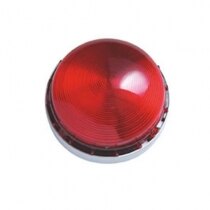-
Contact
Sales & Customer Service
0800 612 6537 support@safelincs.co.uk Live ChatDelivery Enquiries
0800 077 6149 - Resources
Fire & Safety Solutions
CALL OUR TEAM NOW 0800 612 6537
Also FREE from UK mobiles
Free Delivery
on 100s of Products
Live Chat - Online
Instant help & Advice
Trade Discounts
and exclusive pricing
0% Credit Available
Open an account now
5 Star Customer Feedback
Conventional Sounders and Beacons
Providing an adequate amount of time to evacuate a premises in the event of an emergency is critical, so it is important that all occupants of a building receive the earliest possible warning of danger. Designed for use as part of a two wire or four wire fire alarm system, conventional sounders and beacons provide an audible and / or a visual indication when the fire alarm system has been activated. Conventional sounders emit a high decibel output, whilst beacons produce a high intensity strobe light, which are suitable for Disability Discrimination Act (DDA) compliant installations.
Banshee Excel Lite Sounder with LED Beacon - Capsule Horn
- Combined sounder and LED beacon unit
- EN 54-3 tested and VdS approved
- Available in two body colours and two lens colours
- Suitable for use as a fire alarm system indicator
ClamBell Fire Alarm Bell - Vimpex
- Lightweight aluminium construction
- Approved to EN54-3 by LPCB
- Available in three different base types
- Low current consumption and loud sound output
Rafiki Twinflex Hatari Sounder
- Rafiki Hatari Sounder for use with Rafiki Twinflex fire alarm panels
- 92dBA sound output
- Available in red or white
- Designed to comply with the European Standard EN 54 part 3
Rafiki Twinflex Flashpoint Strobe
- Rafiki Flashpoint for use with Rafiki Twinflex fire alarm panels
- LED operation
- Available in either low profile or dome shaped
- Suitable for use as a fire alarm system indicator
AlarmSense Open Area Sounder
- IP65 rated
- Up to 99dB sound output
- Designed for use as part of a CFP AlarmSense fire alarm system
AlarmSense Open Area Sounder Beacon
- Wall mounted
- Combined sounder and beacon
- Wired as a "first-fix" base
- Suitable for use as a fire alarm system indicator
Banshee Excel Lite Sounder with Xenon Beacon - Capsule Horn
- Combined sounder and xenon beacon unit
- Suitable for Disability Discrimination Act compliant installations
- EN 54 part 3 tested and CE marked
- Suitable for use as a fire alarm system indicator
Banshee Excel Sounder - Capsule Horn
- EN 54 part 3 tested and VdS approved
- Fitted with a capsule driven horn
- Available in three different colours and with a standard or deep base
AlarmSense Sounder Base
- Monitors the presence of detectors
- High or low volume setting
- Designed to be used with AlarmSense detectors or cover caps
AlarmSense Combined Sounder/Beacon Base
- Can be fitted with an AlarmSense detector or cover cap
- High and low volume settings
- Gives an audible and visual warning on activation
What is the difference between a sounder and a beacon?
What is the difference between a sounder and a beacon?
The main difference between a sounder and a beacon is that one emits a noise whereas the other emits a bright light.
A sounder is crucial for a fire alarm system, as this is the main device that provides a warning to all occupants of a premises.
A beacon warns occupants of the danger visually, assisting those who may be hearing impaired or deaf.
For an effective fire alarm warning system, it is important to have a mixture of the two. This ensures that everyone who may visit the premises has an equal opportunity of being warned as early as possible of the danger.


























